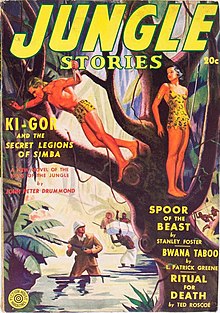
Weird Tales is an American fantasy and horror fiction pulp magazine founded by J. C. Henneberger and J. M. Lansinger in late 1922. The first issue, dated March 1923, appeared on newsstands February 18. The first editor, Edwin Baird, printed early work by H. P. Lovecraft, Seabury Quinn, and Clark Ashton Smith, all of whom went on to be popular writers, but within a year, the magazine was in financial trouble. Henneberger sold his interest in the publisher, Rural Publishing Corporation, to Lansinger, and refinanced Weird Tales, with Farnsworth Wright as the new editor. The first issue to list Wright as editor was dated November 1924. The magazine was more successful under Wright, and despite occasional financial setbacks, it prospered over the next 15 years. Under Wright's control, the magazine lived up to its subtitle, "The Unique Magazine", and published a wide range of unusual fiction.

Unknown was an American pulp fantasy fiction magazine, published from 1939 to 1943 by Street & Smith, and edited by John W. Campbell. Unknown was a companion to Street & Smith's science fiction pulp, Astounding Science Fiction, which was also edited by Campbell at the time; many authors and illustrators contributed to both magazines. The leading fantasy magazine in the 1930s was Weird Tales, which focused on shock and horror. Campbell wanted to publish a fantasy magazine with more finesse and humor than Weird Tales, and put his plans into action when Eric Frank Russell sent him the manuscript of his novel Sinister Barrier, about aliens who own the human race. Unknown's first issue appeared in March 1939; in addition to Sinister Barrier, it included H. L. Gold's "Trouble With Water", a humorous fantasy about a New Yorker who meets a water gnome. Gold's story was the first of many in Unknown to combine commonplace reality with the fantastic.
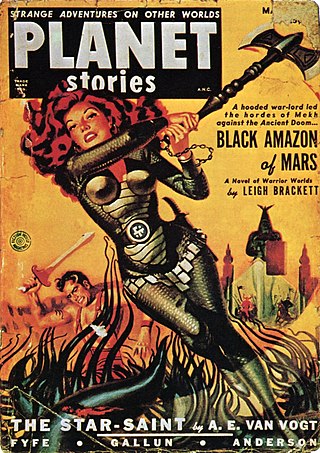
Planet Stories was an American pulp science fiction magazine, published by Fiction House between 1939 and 1955. It featured interplanetary adventures, both in space and on some other planets, and was initially focused on a young readership. Malcolm Reiss was editor or editor-in-chief for all of its 71 issues. Planet Stories was launched at the same time as Planet Comics, the success of which probably helped to fund the early issues of Planet Stories. Planet Stories did not pay well enough to regularly attract the leading science fiction writers of the day, but occasionally obtained work from well-known authors, including Isaac Asimov and Clifford D. Simak. In 1952 Planet Stories published Philip K. Dick's first sale, and printed four more of his stories over the next three years.
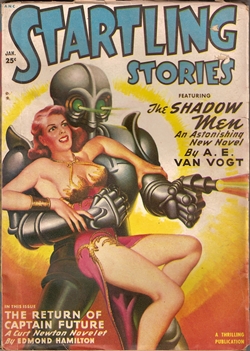
Startling Stories was an American pulp science fiction magazine, published from 1939 to 1955 by publisher Ned Pines' Standard Magazines. It was initially edited by Mort Weisinger, who was also the editor of Thrilling Wonder Stories, Standard's other science fiction title. Startling ran a lead novel in every issue; the first was The Black Flame by Stanley G. Weinbaum. When Standard Magazines acquired Thrilling Wonder in 1936, it also gained the rights to stories published in that magazine's predecessor, Wonder Stories, and selections from this early material were reprinted in Startling as "Hall of Fame" stories. Under Weisinger the magazine focused on younger readers and, when Weisinger was replaced by Oscar J. Friend in 1941, the magazine became even more juvenile in focus, with clichéd cover art and letters answered by a "Sergeant Saturn". Friend was replaced by Sam Merwin Jr. in 1945, and Merwin was able to improve the quality of the fiction substantially, publishing Arthur C. Clarke's Against the Fall of Night, and several other well-received stories.

Fiction House was an American publisher of pulp magazines and comic books that existed from the 1920s to the 1950s. It was founded by John B. "Jack" Kelly and John W. Glenister. By the late 1930s, the publisher was Thurman T. Scott. Its comics division was best known for its pinup-style good girl art, as epitomized by the company's most popular character, Sheena, Queen of the Jungle.
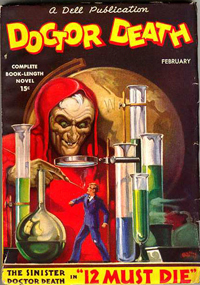
Doctor Death was the title of a short-lived pulp science fiction magazine published by Dell Magazines in 1935, as well as the name of the main character featured in that magazine. Doctor Death was an archcriminal who wanted to return the world to a primitive condition and used supernatural tools such as zombies and magic in his plots against humanity. The stories were written by Harold Ward under the pseudonym of "Zorro". Dell may have intended Doctor Death to be a continuation of a character of the same name in All Detective Magazine, also published by Dell.

Science Fiction Quarterly was an American pulp science fiction magazine that was published from 1940 to 1943 and again from 1951 to 1958. Charles Hornig served as editor for the first two issues; Robert A. W. Lowndes edited the remainder. Science Fiction Quarterly was launched by publisher Louis Silberkleit during a boom in science fiction magazines at the end of the 1930s. Silberkleit launched two other science fiction titles at about the same time: all three ceased publication before the end of World War II, falling prey to slow sales and paper shortages. In 1950 and 1951, as the market improved, Silberkleit relaunched Future Fiction and Science Fiction Quarterly. By the time Science Fiction Quarterly ceased publication in 1958, it was the last surviving science fiction pulp magazine, all other survivors having changed to different formats.
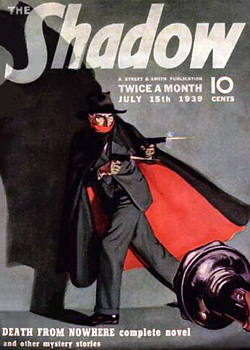
The Shadow was an American pulp magazine that was published by Street & Smith from 1931 to 1949. Each issue contained a novel about the Shadow, a mysterious crime-fighting figure who had been invented to narrate the introductions to radio broadcasts of stories from Street & Smith's Detective Story Magazine. A line from the introduction, "Who knows what evil lurks in the hearts of men? The Shadow knows", prompted listeners to ask at newsstands for the "Shadow magazine", which convinced the publisher that a magazine based around a single character could be successful. Walter Gibson persuaded the magazine's editor, Frank Blackwell, to let him write the first novel, The Living Shadow, which appeared in the first issue, dated April 1931.

Future Science Fiction and Science Fiction Stories were two American science fiction magazines that were published under various names between 1939 and 1943 and again from 1950 to 1960. Both publications were edited by Charles Hornig for the first few issues; Robert W. Lowndes took over in late 1941 and remained editor until the end. The initial launch of the magazines came as part of a boom in science fiction pulp magazine publishing at the end of the 1930s. In 1941 the two magazines were combined into one, titled Future Fiction combined with Science Fiction, but in 1943 wartime paper shortages ended the magazine's run, as Louis Silberkleit, the publisher, decided to focus his resources on his mystery and western magazine titles. In 1950, with the market improving again, Silberkleit relaunched Future Fiction, still in the pulp format. In the mid-1950s he also relaunched Science Fiction, this time under the title Science Fiction Stories. Silberkleit kept both magazines on very slim budgets throughout the 1950s. In 1960 both titles ceased publication when their distributor suddenly dropped all of Silberkleit's titles.

Captain Future was a science fiction pulp magazine launched in 1940 by Better Publications, and edited initially by Mort Weisinger. It featured the adventures of Captain Future, a super-scientist whose real name was Curt Newton, in every issue. All but two of the novels in the magazine were written by Edmond Hamilton; the other two were by Joseph Samachson. The magazine also published other stories that had nothing to do with the title character, including Fredric Brown's first science fiction sale, "Not Yet the End". Captain Future published unabashed space opera, and was, in the words of science fiction historian Mike Ashley, "perhaps the most juvenile" of the science fiction pulps to appear in the early years of World War II. Wartime paper shortages eventually led to the magazine's cancellation: the last issue was dated Spring 1944.

Ka-Zar was an American pulp magazine that published three issues in 1936 and 1937, edited by Martin Goodman. The lead character was modeled after Tarzan and the lead novel and short stories in each issue were adventures set in the jungle.

Captain Hazzard was a science fiction pulp magazine which published one issue in 1938. It was published by Aaron Wyn's Ace Magazines, and edited by Aaron's wife, Rose Wyn. The lead novel, "Python-Men of the Lost City", featured Captain Hazzard, a telepathic superhero; the author's name, "Chester Hawks", was a pseudonym. The magazine also contained some shorter fiction. The lead novel was reprinted in 1974 by Robert Weinberg.

The Spider was an American pulp magazine published by Popular Publications from 1933 to 1943. Every issue included a lead novel featuring The Spider, a heroic crime-fighter. The magazine was intended as a rival to Street & Smith's The Shadow and Standard Magazine's The Phantom Detective, which also featured crime-fighting heroes. The novels in the first two issues were written by R. T. M. Scott; thereafter every lead novel was credited to "Grant Stockbridge", a house name. Norvell Page, a prolific pulp author, wrote most of these; almost all the rest were written by Emile Tepperman and A. H. Bittner. The novel in the final issue was written by Prentice Winchell.
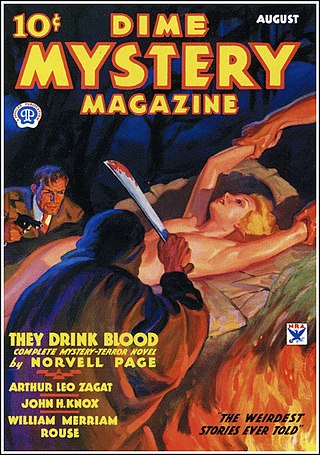
Dime Mystery Magazine was an American pulp magazine published from 1932 to 1950 by Popular Publications. Titled Dime Mystery Book Magazine during its first nine months, it contained ordinary mystery stories, including a full-length novel in each issue, but it was competing with Detective Novels Magazine and Detective Classics, two established magazines from a rival publisher, and failed to sell well. With the October 1933 issue the editorial policy changed, and it began publishing horror stories. Under the new policy, each story's protagonist had to struggle against something that appeared to be supernatural, but would eventually be revealed to have an everyday explanation. The new genre became known as "weird menace" fiction; the publisher, Harry Steeger, was inspired to create the new policy by the gory dramatizations he had seen at the Grand Guignol theater in Paris. Stories based on supernatural events were rare in Dime Mystery, but did occasionally appear.
The Western Raider was an American pulp magazine. The first issue was dated August/September 1938; it was followed by two more issues under that title, publishing Western fiction, and then was changed to a crime fiction pulp for two issues, titled The Octopus and The Scorpion. Both these two issues were named after a supervillain, rather than after a hero who fights crime, as was the case with most such magazines. Norvell Page wrote the lead novels for both the crime fiction issues; the second was rewritten by Ejler Jakobsson, one of the editors, to change the character from The Octopus to The Scorpion.

The Mysterious Wu Fang was a pulp magazine which published seven issues in 1935 and 1936. Sax Rohmer's Fu Manchu, an oriental villain, was a "yellow peril" stereotype, and Popular Publications wanted to take advantage of the public's interest. The author of all seven lead novels was Robert J. Hogan, who was simultaneously writing the novels for G-8 and His Battle Aces, producing 130,000 to 150,000 words per month; Hogan was told not to rewrite, but to deliver his first drafts. The hero of the novels was a man named Val Kildare; other characters included a young assistant to Kildare, who was probably added to attract younger readers. The artist John Richard Flanagan, who had experience illustrating Fu Manchu, was hired, but in the opinion of pulp historian Robert Weinberg, "an imitation was an imitation, and the magazine did not sell well". There were short stories along with the lead novel in each issue, also with a "yellow peril" theme; the authors included Steve Fisher, Frank Gruber, O.B. Meyers, and Frank Beaston. The magazine was cancelled after seven issues in favor of a similar magazine with a different villain: Dr. Yen Sin. According to pulp historian Joseph Lewandowski, the decision to switch titles may have been because Wu Fang was too juvenile, and Dr. Yen Sin was supposed to be more mature.

Operator #5 was a pulp magazine published between 1934 and 1939.

Captain Zero was an American pulp magazine that published three issues in 1949 and 1950. The lead novels, written by G.T. Fleming-Roberts, featured Lee Allyn, who had been the subject of an experiment with radiation, and as a result was invisible between midnight and dawn. Under the name Captain Zero, Allyn became a vigilante, fighting crime at night. Allyn had no other superpowers, and the novels were straightforward mysteries in Weinberg's opinion, though pulp historian Robert Sampson considers them to be "complex...[they] pound along with hair-raising incidents..full of twists and high suspense". Captain Zero was the last crime-fighter hero magazine to be launched in the pulp era, ending an era that had begun with The Shadow in 1931. There was room in the magazine for only one or two short stories along with the lead novel; these were all straight mystery stories, without the veneer of science fiction of the Captain Zero novels.

G-8 and His Battle Aces was an American air-war pulp magazine published from 1930 to 1944. It was one of the first four magazines launched by Popular Publications when it began operations in 1930, and first appeared for just over two years under the title Battle Aces. The success of Street & Smith's The Shadow, a hero pulp, led Popular to follow suit in 1933 by relaunching Battle Aces as a hero pulp: the new title was G-8 and His Battle Aces, and the hero, G-8, was a top pilot and a spy. Robert J. Hogan wrote the lead novels for all the G-8 stories, which were set in World War I. Hogan's plots featured the Germans threatening the Allied forces with extraordinary or fantastic schemes, such as giant bats, zombies, and Martians. He often contributed stories to the magazines as well as the lead novel, though not all the short stories were by him. The cover illustrations, by Frederick Blakeslee, were noted for their fidelity to actual planes flown in World War I.

Battle Birds was an American air-war pulp magazine, published by Popular Publications. It was launched at the end of 1932, but did not sell well, and in 1934 the publisher turned it into an air-war hero pulp titled Dusty Ayres and His Battle Birds. Robert Sidney Bowen, an established pulp writer, provided the lead novel each month, and also wrote the short stories that filled out the issue. Bowen's stories were set in the future, with the United States menaced by an Asian empire called the Black Invaders. The change was not successful enough to be extended beyond the initial plan of a year, and Bowen wrote a novel in which, unusually for pulp fiction, Dusty Ayres finally defeated the invaders, to end the series. The magazine ceased publication with the July/August 1935 issue. It restarted in 1940, under the original title, Battle Birds, and lasted for another four years. All the cover art was painted by Frederick Blakeslee.
